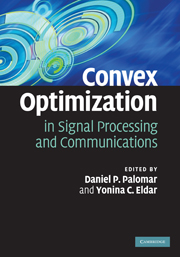Book contents
- Frontmatter
- Contents
- List of contributors
- Preface
- 1 Automatic code generation for real-time convex optimization
- 2 Gradient-based algorithms with applications to signal-recovery problems
- 3 Graphical models of autoregressive processes
- 4 SDP relaxation of homogeneous quadratic optimization: approximation bounds and applications
- 5 Probabilistic analysis of semidefinite relaxation detectors for multiple-input, multiple-output systems
- 6 Semidefinite programming, matrix decomposition, and radar code design
- 7 Convex analysis for non-negative blind source separation with application in imaging
- 8 Optimization techniques in modern sampling theory
- 9 Robust broadband adaptive beamforming using convex optimization
- 10 Cooperative distributed multi-agent optimization
- 11 Competitive optimization of cognitive radio MIMO systems via game theory
- 12 Nash equilibria: the variational approach
- Afterword
- Index
8 - Optimization techniques in modern sampling theory
Published online by Cambridge University Press: 23 February 2011
- Frontmatter
- Contents
- List of contributors
- Preface
- 1 Automatic code generation for real-time convex optimization
- 2 Gradient-based algorithms with applications to signal-recovery problems
- 3 Graphical models of autoregressive processes
- 4 SDP relaxation of homogeneous quadratic optimization: approximation bounds and applications
- 5 Probabilistic analysis of semidefinite relaxation detectors for multiple-input, multiple-output systems
- 6 Semidefinite programming, matrix decomposition, and radar code design
- 7 Convex analysis for non-negative blind source separation with application in imaging
- 8 Optimization techniques in modern sampling theory
- 9 Robust broadband adaptive beamforming using convex optimization
- 10 Cooperative distributed multi-agent optimization
- 11 Competitive optimization of cognitive radio MIMO systems via game theory
- 12 Nash equilibria: the variational approach
- Afterword
- Index
Summary
Sampling theory has benefited from a surge of research in recent years, due in part to intense research in wavelet theory and the connections made between the two fields. In this chapter we present several extensions of the Shannon theorem, which treat a wide class of input signals, as well as nonideal-sampling and constrained-recovery procedures. This framework is based on an optimization viewpoint, which takes into account both the goodness of fit of the reconstructed signal to the given samples, as well as relevant prior knowledge on the original signal. Our exposition is based on a Hilbert-space interpretation of sampling techniques, and relies on the concepts of bases (frames) and projections. The reconstruction algorithms developed in this chapter lead to improvement over standard interpolation approaches in signal- and image-processing applications.
Introduction
Sampling theory treats the recovery of a continuous-time signal from a discrete set of measurements. This field attracted significant attention in the engineering community ever since the pioneering work of Shannon [1] (also attributed to Whitaker [2], Kotelnikov [3], and Nyquist [4]) on sampling bandlimited signals. Discrete-time signal processing (DSP) inherently relies on sampling a continuous-time signal to obtain a discrete-time representation. Therefore, with the rapid development of digital applications, the theory of sampling has gained importance.
Traditionally, sampling theories addressed the problem of perfectly reconstructing a given class of signals from their samples.
- Type
- Chapter
- Information
- Convex Optimization in Signal Processing and Communications , pp. 266 - 314Publisher: Cambridge University PressPrint publication year: 2009

